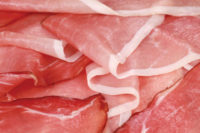On a Wing and a Dare
In what could be viewed as a daring move, Foster Farms’ cooked chicken plant in Porterville, Calif., expanded wing-processing capacity in hopes of capturing key foodservice accounts.
Foster Farms’ cooked chicken plant in Porterville, Calif., might turn out oodles of chicken wings — 31 million pounds a year — but its employees definitely are not “winging it” when it comes to day-to-day operations. At this facility, it’s all about attention to detail.
That philosophy is embedded in Foster Farms’ company values, explains Paul Bravinder, manager of cooked chicken and a 23-year industry veteran who joined Foster Farms in 2001.
“It’s all about making sure that what you’re doing is correct every time,” he says. “And if you don’t get it correct, asking, ‘What are you going to do to fix it so it doesn’t happen again?’”
Based on its impressive growth, it appears likely that this facility — a former diaper factory that Foster Farms acquired in the late 1990s, refurbished and opened in 1999 with two processing lines — is getting it correct much more often than not. Early business was so good, in fact, that the plant installed a third line in 2001. A major expansion completed in 2005 added a fourth line and increased overall square footage from 85,000 to 125,000.
Although the plant also produces millions of pounds annually of cooked chicken strips, whole-muscle products, formed chicken products, mini corn dogs and pizza toppings for retail and foodservice, the most recent expansion was a strategic decision to support Foster Farm’s wing business, stresses Bravinder.
“We made a decision as a company to get serious as far as the wing business is concerned,” he says. “Prior to last year, we were producing all of the formed product, as well as the wings, on the same line. What [the expansion] did is allow us to dedicate this line 100 percent to our wing manufacturing, and that allowed us to go after some key wing accounts.”
The expansion increased capacity by approximately 30 percent, says Bravinder, and required the addition of 60 new full-time positions, bringing the facility’s headcount to 400. Most importantly, the expansion landed the company accounts with key foodservice operators on the West Coast.
Consistent with Foster Farms’ attention-to-detail philosophy, Porterville plant management continues to look for ways to improve the new line.
“We’re continually making improvements,” Bravinder notes. “It’s industry-standard equipment, but it’s the high-capacity line that we needed. One of the things that we’ve been working on is automated delivery of wings to the line.”
Facility management also is proud of key enhancements made to other lines.
“As far as our strips and whole-muscle products are concerned, we modified the line to make it a linear process,” says Bravinder. “In the past, we batched it in one area and then brought it over to the processing line. That’s probably one of the lines that’s the most automated and gives us the least amount of trouble.”
As for the “pop dog,” or mini corn dog, line, Bravinder calls it “one of the most efficient in the industry” compared to other lines processing the same type of product. Plant employees have spent the last four or five years improving the proprietary process used here, he adds. The facility produces about 11 million pounds of mini corn dogs a year. Unlike many of the other cooked products, which are distributed regionally, these items are distributed nationally.
Eye on quality, safety
At the Porterville plant, attention to detail extends well beyond line capacity and efficiency improvements — personnel also keep a very close eye on food quality and food and employee safety.
“We follow very strict [good manufacturing processes],” stresses Alice Craft McLaughlin, the plant’s quality control manager and a 15-year industry veteran.
Plant employees receive due diligence training, she says, and the plant follows a strict packaging control program. Moreover, the facility employs non-food contact testing, food contact testing and 100 percent product testing.
“We have a very good sanitation supplier that specializes in cooked plants and smoked house plants — our relationship allows us to keep up with the latest technology,” says Neal Jones, facility manager and a 30-year food processing veteran. “We do a tremendous amount of testing, from Alice’s standpoint and mine. Lots of attention to pathogen-control details.”
To minimize cross-contamination, the plant schedules food-product production according to allergen content, says Craft McLaughlin, from those containing the least amount to those containing the most. In addition, raw and cooked lines are completely segregated — even employee break rooms are separated.
Required attire in most processing areas is a bit stricter than “industry standard,” and includes a smock (different colors for different areas; with pockets tucked inside to minimize the risk of dropped items), boots, gloves, earplugs, a face mask (to cover the mouth) and a hair net/beard net. In a step beyond routine hand and foot washes, processing floors also are treated with special pellets that sanitize floors when people step on the pellets.
Third-party audits provide yet another checkpoint here, says Craft McLaughlin.
“Depending on the customer, we’re probably averaging four to six a year,” she says. “It’s all customer-driven.”
The Porterville plant also audits some of its vendors, she adds, including some supplying “high-risk” ingredients such as wing sauces. Most of its chicken, however, is sourced from three other Foster Farms plants.
Management is just as diligent when it comes to employee safety.
“We perform weekly safety audits where we include hourly employees to go through with the supervisor, superintendent, and that makes them part of the process,” says Bravinder. “We have monthly safety training where all supervisors hold meetings with their employees for anywhere from 15 minutes to a half hour. … We have a safety committee and we have an executive safety committee as well. We get together once a month and cover six different [safety] categories.”
To further improve safety efforts, plant management created an incentive program last year that allows an employee to acquire points for each quarter in which he or she attains a perfect safety record. The employee then can trade in the points for prizes during scheduled quarterly safety celebrations, says Bravinder.
“It’s really been a good incentive,” he says. “One of the fears was that employees wouldn’t report injuries, but we’ve gone the other route with them and said, ‘you have to report these injuries. … Our incidence rate has remained about the same, but our severity rate has been reduced.”
Ergonomics efforts also are in place to help reduce or eliminate repetitive-stress types of injuries, Bravinder notes.
“That’s a committee in itself, and one of the main things we do is rotation. We rotate hourly employees every two to three hours, depending on the job. We have [job-specific task analyses] that describe the job itself and the ergonomic impact.”
Building on success
Although Bravinder is justifiably proud of the Porterville facility’s accomplishments, he also is quick to point out its ongoing challenges.
“We still have some capacity left as far as sales are concerned,” he says. “But the main thing is to make the daily routines automatic routines, because the biggest challenge you have with new plants is just to get it engrained into the employees — both management and hourly — that we don’t need to have the same issues every day.
“We’ve done a very good job; Neal and Alice have done a very good job just getting to that point,” he adds, “but we need to expand on that daily. You almost want the process to be boring, and it never is, of course.”
Yet another challenge is employee retention, says Bravinder. A small subset, 10 to 20 percent of the plant’s workforce, is constantly revolving.
“It’s difficult to retain them at times, but I also think the workforce has changed over the years,” he says. “This isn’t a glamorous industry.”
But plant management maintains a “very close relationship” with the bulk of its employees, stresses Bravinder — even hosting weekly employee roundtable sessions in which hourly employees can discuss issues they might be having out on the floor.
As the second-largest employer in Porterville, the plant also makes sure to keep a good relationship with the city.
“We have quarterly meetings with the city,” he says. They invite all managers from the various industries here. … We meet with them to discuss city concerns as they related to our respective plants. … We have a very good relationship with them as far as our wastewater treatment facility is concerned, as well.”
The Porterville plant has been particularly proactive in the wastewater treatment area — and in other environmental initiatives. Its on-site wastewater treatment facility uses a new dry flocculant that handles a constantly changing wastewater flow, notes Jones, and allows the plant to eliminate multiple tanks for different liquids. In addition, the plant has “very good measures” in place to treat the exhaust from its three ovens and three fryers.
One final challenge for the plant is to maintain as much uptime as possible.
“This plant is [Foster Farms’] only cooked chicken facility,” Bravinder says. “Neal has made some good changes on the general maintenance side to make sure that we don’t have any significant downtime, because we’re the only producer for the company. We have an uptime goal of 92 percent minimum, which we are achieving. But it’s important to continue to do that.”


